Internet Service Provider Business Plan
Web Services Provider’s target markets for DSL are small and medium businesses nationwide. For Web hosting and resale accounts, the target markets are Web design firms, individuals, and small businesses in need of server space. Dedicated servers cater to small to large companies that require high security and speed. Co-location services are aimed at medium and small businesses, including online trading, e-tailers, online information sites, and entertainment Web companies.
Computer telephony integration (CTI) represents the convergence of the telephone and computing industries. Currently, the CTI market is valued at $4 billion and is growing at a rate of 30% annually, with some segments experiencing over 100% growth. The MultiMedia Telecommunications Association based in Washington predicts a 70% growth in the CTI market in the next year and a three-fold increase by the year 2000.
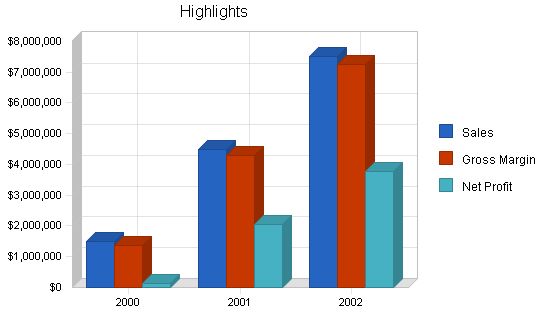
Web Services Provider’s mission is to offer quality Internet services, Web hosting, and DSL service to large and small clients.
Web Services Provider was founded in September 1993 as an Internet Service Provider based in Richmond, Virginia. The company is a Virginia Corporation with offices located in Richmond.
Initially, Web Services Provider focused on Web hosting. They developed a skilled engineering team dedicated to creating a system that provides clients with reliable and affordable bandwidth. With their expertise in Web hosting systems, Web Services Provider has now evolved into a specialized and large Web hosting service provider.
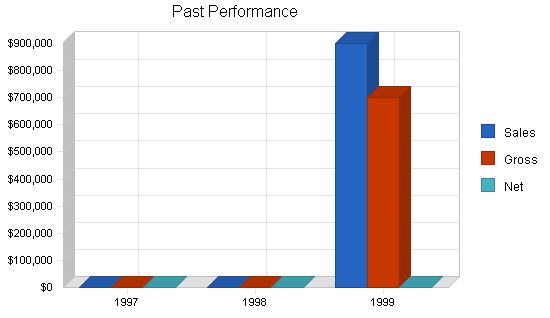
Past Performance
Sales:
– 1997: $0
– 1998: $0
– 1999: $900,000
Gross Margin:
– 1997: $0
– 1998: $0
– 1999: $700,000
Gross Margin %:
– 1997: 0.00%
– 1998: 0.00%
– 1999: 77.78%
Operating Expenses:
– 1997: $0
– 1998: $0
– 1999: $700,000
Collection Period (days):
– 1997: 0
– 1998: 0
– 1999: 3
Balance Sheet
Current Assets
Cash:
– 1997: $0
– 1998: $0
– 1999: $2,450
Accounts Receivable:
– 1997: $0
– 1998: $0
– 1999: $14,200
Other Current Assets:
– 1997: $0
– 1998: $0
– 1999: $1,050
Total Current Assets:
– 1997: $0
– 1998: $0
– 1999: $17,700
Long-term Assets
Long-term Assets:
– 1997: $0
– 1998: $0
– 1999: $5,250
Accumulated Depreciation:
– 1997: $0
– 1998: $0
– 1999: $1,000
Total Long-term Assets:
– 1997: $0
– 1998: $0
– 1999: $4,250
Total Assets:
– 1997: $0
– 1998: $0
– 1999: $21,950
Current Liabilities
Accounts Payable:
– 1997: $0
– 1998: $0
– 1999: $10,000
Current Borrowing:
– 1997: $0
– 1998: $0
– 1999: $500
Other Current Liabilities (interest free):
– 1997: $0
– 1998: $0
– 1999: $10,900
Total Current Liabilities:
– 1997: $0
– 1998: $0
– 1999: $21,400
Long-term Liabilities:
– 1997: $0
– 1998: $0
– 1999: $3,550
Total Liabilities:
– 1997: $0
– 1998: $0
– 1999: $24,950
Paid-in Capital:
– 1997: $0
– 1998: $0
– 1999: $100,000
Retained Earnings:
– 1997: $0
– 1998: $0
– 1999: ($103,000)
Earnings:
– 1997: $0
– 1998: $0
– 1999: $0
Total Capital:
– 1997: $0
– 1998: $0
– 1999: ($3,000)
Total Capital and Liabilities:
– 1997: $0
– 1998: $0
– 1999: $21,950
Other Inputs
Payment Days:
– 1997: 0
– 1998: 0
– 1999: 30
Sales on Credit:
– 1997: $0
– 1998: $0
– 1999: $900,000
Receivables Turnover:
– 1997: 0.00
– 1998: 0.00
– 1999: 63.38
Services
Main services provided by Web Services Provider:
1. DSL: High-speed Internet access, "on all the time" connection, transfer rate ranges from 144k to 6Gb.
2. Hosting: Placing and operating websites on a server, payment based on disk space needed.
3. Dedicated Server: Leasing a server for maximum speed and performance.
4. Co-location: Customers provide their own hardware and administer sites via the Internet.
When hosting and dedicated server clients are secured, orders will be processed immediately and the customer can be up and running within a few minutes. Dedicated server clients can be online within 1-2 hours unless a special server must be built.
Future Services
Web Services Provider will continue to search for emerging and existing technologies to improve and expand lines of business. As technology advances, Web Services Provider will upgrade to meet objectives of present and future clientele. Web Services Provider plans to respond to market needs, be first to market, and move quickly on plans for next-generation products/services.
Market Analysis Summary
Web Services Provider’s key markets for DSL are small and medium businesses nationwide. Its key markets for web hosting and resale accounts are web design firms, individuals, and small businesses. Key markets for dedicated servers are small to large companies requiring security and speed. Key markets for co-location include medium and small businesses such as online trading, e-tailers, online information sites, and entertainment companies.
Within these markets, Web Services Provider focuses on more lucrative dedicated server and co-location clientele which create less overhead and more profit. Its margins are 40%-80% on larger and medium-sized clients.
Consumer Shopping Experience
The Internet has provided consumers with convenience and information. Online shopping allows consumers to make purchases without leaving home or office, particularly for non-urgent items like books, CDs, or apparel.
Consumers can easily research products online, gathering information to make informed decisions about major purchases. Comparison shopping is simple, with search engines providing price lists and links to selling websites. This easy access to information will likely lead to price declines in many categories of goods over time.
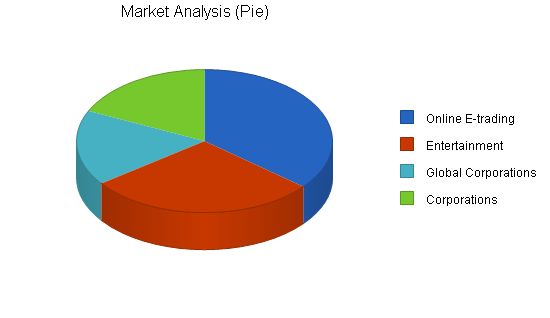
Market Analysis
Potential Customers Growth 2000 2001 2002 2003 2004 CAGR
Online E-trading 15% 200,000 230,000 264,500 304,175 349,801 15.00%
Entertainment 10% 160,000 176,000 193,600 212,960 234,256 10.00%
Global Corporations 15% 95,000 109,250 125,638 144,484 166,157 15.00%
Corporations 10% 100,000 110,000 121,000 133,100 146,410 10.00%
Total 12.74% 555,000 625,250 704,738 794,719 896,624 12.74%
4.1 Market Segmentation
Web Services Provider aims to establish itself in markets that define the future of Web hosting. The company pursues dedicated server and co-location accounts, online trading companies, and e-entertainment companies because they need bandwidth, 24-hour access, faster connections, and other services which the company provides.
The company’s target customers are:
– Online E-trading.
– Entertainment.
– Global Corporations.
– Corporations.
The Internet
As of year-end 1998, almost 160 million users accessed the Internet regularly, up from approximately 101 million in 1997, according to IDC, an industry analysis and research company. The Internet is in an exceptional growth phase. This growth has pushed the capacity of existing networking infrastructure to its limits, frustrating Internet users.
Consumers have found the Internet to be a useful tool in the research and purchase of goods and services. Corporations have found that the Internet offers significant advantages to companies that fully embrace the medium.
4.2 Market Trends
Exceptional growth
By any measure, the Internet is one of the fastest-growing commercial phenomena ever witnessed. Host computers, or servers, have exploded from 3.2 million in 1994 to roughly 56.2 million as of July 1999. During the same time period, the number of websites roared to more than 5 million from only 3,000.
A key factor in the recent growth of the Internet is the popularity of the sub-$1,000 PC. Rapidly falling component prices have allowed PC manufacturers to pass cost savings on to their customers, resulting in a more attractively priced product. Computers sold at or below $1,000 have appealed to first-time PC users and lower-income families. Because of the more affordable prices, PC penetration in the United States is now approximately 50%, according to Dataquest, a market research firm based in San Jose, California.
As a result of the Internet’s historical roots in the U.S. Department of Defense, as well as the rising penetration of PCs, the United States accounts for more than half of the world’s total Internet users. The European market has been held back by the high cost of Internet access, but telecommunications deregulation in Europe is having an effect as several phone companies have eliminated access fees. Such moves should increase the penetration of the Internet in Europe.
Far-reaching benefits
Although the Internet is still evolving as a medium for communications and commerce, it has already had a substantial impact on both consumers and businesses. For consumers, online shopping has brought greater convenience, while businesses have enjoyed productivity gains.
4.3 Market Growth
Bandwidth bottlenecks frustrate consumers…
Today’s telecommunications network infrastructure was not designed for the booming traffic created by Internet use. Ordinary telephone lines are optimized for short conversations, whereas Internet users typically stay online for hours at a time. Growing corporate use of the Internet to communicate with suppliers and customers has put additional strains on the system.
Adding to the capacity problem are multimedia attachments to email, more complex multimedia websites, larger files being downloaded by users, and other bandwidth-hungry applications. Although the predicted global meltdown of the Internet has not come to pass, delays in navigating the Web and receiving email continue to plague the industry and frustrate users.
…But solutions are on the way
The vast majority of Internet users use dial-up modems to access the Internet through their ISPs. Analog modem technology offers a maximum capacity of 56 kilobits per second for most residential customers.
New technologies, such as cable modems and digital subscriber line (DSL) systems, promise a quantum leap in bandwidth: up to 30 megabytes per second (Mbps) and 12 Mbps, respectively. Both technologies also offer an added advantage in that they are always “on”: a consumer need not physically dial into an ISP to access the Internet.
Cable modems. The nascent market for cable modems is beginning to exhibit strong growth. The number of cable Internet service subscribers numbered more than 1 million as of July 1999, up from 500,000 in 1998. The current leaders in this burgeoning market are Excite@Home and RoadRunner.
Digital subscriber lines. These systems allow telephone companies to offer faster service over copper wires. The number of DSL subscribers was approximately 20,000 in 1998. The fastest form of DSL is asymmetric digital subscriber line, or ADSL.
Limitations
Aside from bandwidth constraints, another more serious problem has recently been brought to light, which threatens to forestall the previously explosive growth of the Internet. According to a study conducted by the Department of Commerce, significant disparities continue to exist between certain demographic groups and regions with regard to Internet access.
Far-reaching benefits
The Internet is still evolving as a medium for communications and commerce, but it has already had a substantial impact on both consumers and businesses. For consumers, online shopping has brought greater convenience, while businesses have enjoyed productivity gains.
4.4 Competition and Buying Patterns
Competitive threats come from established hosting companies with large amounts of operating capital. Their weaknesses are that, even with strong brand awareness, they cannot afford to move their facilities. This ties them to their current locations, which lack adequate bandwidth, speed, and reliability due to their connections through local telco connectivity.
Web Services Provider’s competitors include other XDSL resellers, online Web hosting companies, companies providing single site Web servers for increased speed and reliability, and Web hosting companies offering customer or vendor provided large server or servers housed in their facilities.
Strategy and Implementation Summary
Marketing
Web Services Provider markets its products as solutions to high traffic and bandwidth-intensive Web companies whose online reliability and speed are critical to daily business. Target companies include online stock trading companies, e-tailers, and corporations with graphics and/or streaming video.
Sales are made through Web Services Providers’ national advertising campaign. The sales process involves several steps, including the first contact when the perspective customers first impression is made while viewing one of the magazines in which we advertise. At this point, the customer will call our sales line or go to our website. The customer can then call the sales line where a trained representative will answer questions and proceed with initiating service and billing. The average sales cycle from first contact to closing the sale is between one and seven days.
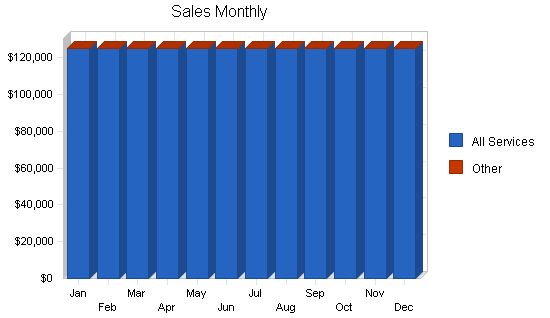
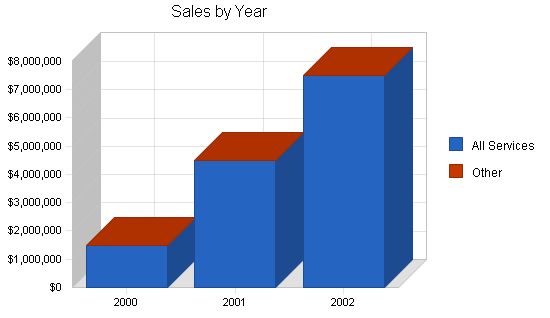
2000 2001 2002
Sales
All Services $1,500,000 $4,500,000 $7,500,000
Other $0 $0 $0
Total Sales $1,500,000 $4,500,000 $7,500,000
Direct Cost of Sales
2000 2001 2002
All Services $100,000 $150,000 $200,000
Other $0 $0 $0
Subtotal Direct Cost of Sales $100,000 $150,000 $200,000
Web Services Provider’s products and services offer the following advantages: bandwidth, reliability, service, and flexibility.
To develop good business strategies, perform a SWOT analysis of your business. Use our free guide and template to learn how.
Competitive Edge
Strategic alliance with VISP – VISP is opening two new facilities in the next three months, one in Atlanta and one in Seattle. Web Services Provider will have access to space on both sites, and with special load-balancing software, will guarantee 100% uptime for any dedicated server and co-location client where uptime is critical.
AB 299 Internet Connection – more beneficial than the tier system; a tier 1 connection means direct connection to the Internet.
Downtime-Dynamic load balancing – a large part of the problem and downtime with an Internet connection for hosting companies is due to the local phone company.
Price – due to the tier 1 connection, Web Services Provider does not have to pay local phone companies connection fees and, as such, its prices are lower than those of competitors.
The Web Services Provider strategy is to advertise key competitive advantages in an effective advertising campaign. The company plans to develop a larger clientele and maintain a price advantage through rapid growth. The company’s goal in the next year is to grow its core customer base quickly and efficiently while focusing on the most profitable sector of the market. The company’s goal in 2-5 years is to grow through acquisitions of smaller companies and separate itself from the competition by price and services.
Distribution Strategy
Web Services Provider uses a direct sales force, relationship selling, and sales/support lines to reach its markets. These channels are most appropriate because each customer has special demands and needs to be treated differently. After the initial contact, by magazine, referral, or email, the customer is assessed and assigned a sales rep and tech support person to help them and to familiarize themselves with each individual company’s needs and history.
Marketing Programs
The key message associated with the company’s products and services is better reliability, speed, and bandwidth for the same price. The company’s promotional plan is diverse and includes a range of marketing communications:
1. Public relations – Press releases are issued to technical trade journals and major business publications such as Wall Street Journal, Business Week, and others.
2. Trade shows – Company representatives attend and participate in trade shows such as Apex and Comdex.
3. Industry conferences and seminars, research publishing, and print media – Web Services Provider presents its key advantages at conferences and publishes articles about its work in publications such as e-business Advisor, Wired, Microsoft Internet Developer, Web Techniques, Business 2.0, and PC Computing. Local and national public relations will be handled by Creative Garage II’s marketing firm.
4. Print advertising and article publishing – The company’s print advertising program includes advertisements in technical trade publications such as E-business Journal, Wired, Web Techniques, Microsoft Internet Developer, Business 2.0, PC Computing, direct mail pieces, brochures, and other print media.
5. Internet – The company plans to redevelop its current website as its primary marketing channel.
Strategic Alliances
The company has strategic alliances with VISP, providing a direct connection to an AB-299 Internet connection with unlimited bandwidth. This relationship is explored more in the Competitive Advantages section.
Management Summary
The company’s management philosophy is based on responsibility and mutual respect. Web Services Provider has an environment and structure that encourages productivity and respect for customers and fellow employees.
Officers and Key Employees:
Michael Smith, President and CEO.
James Boyd, Vice President.
Note: Backgrounds have been removed for confidentiality.
Personnel Plan:
2000 2001 2002
Marketing and Sales $150,000 $198,000 $254,000
Technical Services $150,000 $198,000 $254,000
Accounting $60,000 $99,000 $136,000
Administrative and HR $120,000 $132,000 $194,000
Total People 15 18 22
Total Payroll $480,000 $627,000 $838,000
Funding Requirements and Uses
The company is raising significant new investment for the purpose of growth and operations. This funding will cover operating expenses and product development during this period.
Important Assumptions
The company operates as a Virginia Corporation. The following financial projection is based on sales volume at the levels described in the revenue section and presents the company’s expected assets, liabilities, capital, revenues, and expenses. The projections reflect management’s judgment of the expected conditions and its expected course of action given the hypothetical assumptions.
The table below provides significant assumptions that drive the company’s financial projections.
General Assumptions:
2000 2001 2002
Plan Month 1 2 3
Current Interest Rate 10.00% 10.00% 10.00%
Long-term Interest Rate 10.00% 10.00% 10.00%
Tax Rate 25.42% 25.00% 25.42%
Other 0 0 0
Break-even Analysis
The following chart and table provide the Break-even Assumptions for Web Services Provider.
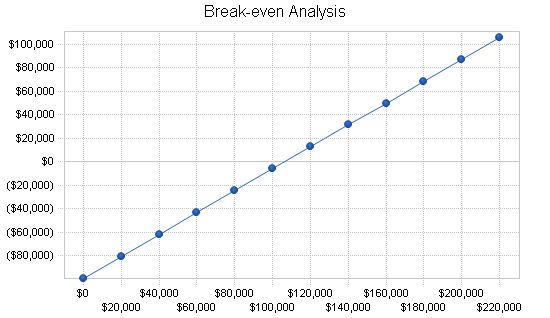
Break-even Analysis:
Monthly Revenue Break-even: $106,438
Assumptions:
– Average Percent Variable Cost: 7%
– Estimated Monthly Fixed Cost: $99,342
Projected Profit and Loss:
Web Services Provider is in the early stage of development, so initial projections are based on accounts that are expected to drive the income statement.
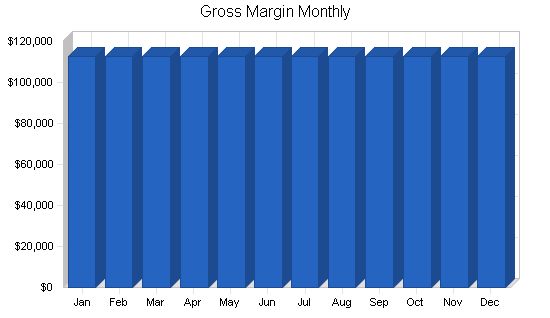
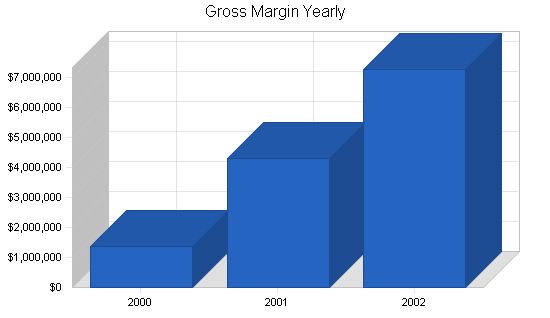
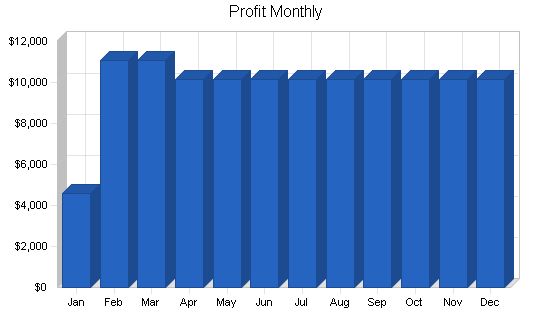
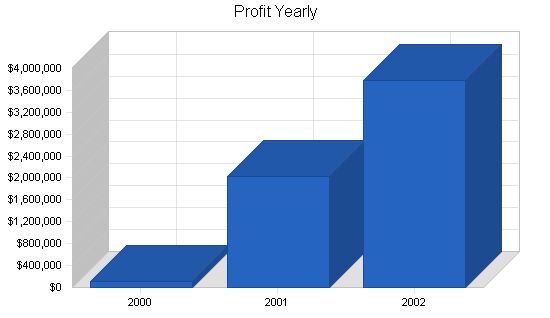
Pro Forma Profit and Loss
| Pro Forma Profit and Loss | |||
| 2000 | 2001 | 2002 | |
| Sales | $1,500,000 | $4,500,000 | $7,500,000 |
| Direct Cost of Sales | $100,000 | $150,000 | $200,000 |
| Other | $50,000 | $50,000 | $50,000 |
| Total Cost of Sales | $150,000 | $200,000 | $250,000 |
| Gross Margin | $1,350,000 | $4,300,000 | $7,250,000 |
| Gross Margin % | 90.00% | 95.56% | 96.67% |
| Expenses | |||
| Payroll | $480,000 | $627,000 | $838,000 |
| Sales and Marketing and Other Expenses | $249,500 | $453,000 | $675,000 |
| Depreciation | $4,200 | $4,500 | $5,000 |
| Repairs and Maintenance | $12,000 | $18,000 | $30,000 |
| Bank Charges | $2,000 | $2,000 | $2,000 |
| Insurance | $6,000 | $7,000 | $8,000 |
| Rent | $40,000 | $45,000 | $48,000 |
| Depreciation | $14,400 | $20,000 | $20,000 |
| Software | $12,000 | $15,000 | $24,000 |
| Product Development | $300,000 | $300,000 | $400,000 |
| Payroll Taxes | $72,000 | $94,050 | $125,700 |
| Other | $0 | $0 | $0 |
| Total Operating Expenses | $1,192,100 | $1,585,550 | $2,175,700 |
| Profit Before Interest and Taxes | $157,900 | $2,714,450 | $5,074,300 |
| EBITDA | $162,100 | $2,718,950 | $5,079,300 |
| Interest Expense | $0 | $0 | $0 |
| Taxes Incurred | $39,802 | $678,613 | $1,289,718 |
| Net Profit | $118,098 | $2,035,838 | $3,784,582 |
| Net Profit/Sales | 7.87% | 45.24% | 50.46% |
7.4 Projected Cash Flow
The chart and table below show the projected cash flow for the company.
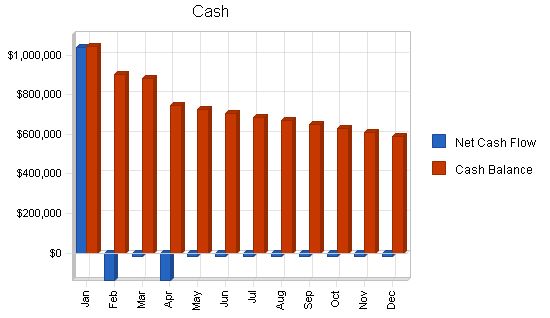
Pro Forma Cash Flow
| Pro Forma Cash Flow | |||
| 2000 | 2001 | 2002 | |
| Cash Received | |||
| Cash from Operations | |||
| Cash Sales | $0 | $0 | $0 |
| Cash from Receivables | $1,268,367 | $4,008,333 | $7,008,333 |
| Subtotal Cash from Operations | $1,268,367 | $4,008,333 | $7,008,333 |
| Additional Cash Received | |||
| Sales Tax, VAT, HST/GST Received | $0 | $0 | $0 |
| New Current Borrowing | $0 | $0 | $0 |
| New Other Liabilities (interest-free) | $0 | $0 | $0 |
| New Long-term Liabilities | $0 | $0 | $0 |
| Sales of Other Current Assets | $0 | $0 | $0 |
| Sales of Long-term Assets | $0 | $0 | $0 |
| New Investment Received | $1,250,000 | $0 | $0 |
| Subtotal Cash Received | $2,518,367 | $4,008,333 | $7,008,333 |
Projected Balance Sheet
| Projected Balance Sheet | |||
| 2000 | 2001 | 2002 | |
| Assets | |||
| Current Assets | |||
| Cash | $590,184 | $1,917,466 | $5,000,840 |
| Accounts Receivable | $245,833 | $737,500 | $1,229,167 |
| Other Current Assets | $1,050 | $1,050 | $1,050 |
| Total Current Assets | $837,068 | $2,656,016 | $6,231,057 |
| Long-term Assets | |||
| Long-term Assets | $605,250 | $905,250 | $1,205,250 |
| Accumulated Depreciation | $5,200 | $9,700 | $14,700 |
| Total Long-term Assets | $600,050 | $895,550 | $1,190,550 |
| Total Assets | $1,437,118 | $3,551,566 | $7,421,607 |
| Ratio Analysis | |||||||||||||||||||||||||||||||||||||||||||||||||||||||||||||||||||||||||||||||||||||||||||||||||||||||||||||||||||||||||||||||||||||||||||||||||||||||||||||||||||||||||||||||||||||||||||||||||||||||||||||||||||||||||||||||||||||||||||||||||||||||||||||||||||||||||||||||||||||||||||||||||||||||||||||||||||||||||||||||||||||||||||||||||||||||||||||||||||||||||||||||||||||||||||||||||||||||||||
| 2000 | 2001 | 2002 | Industry Profile | ||||||||||||||||||||||||||||||||||||||||||||||||||||||||||||||||||||||||||||||||||||||||||||||||||||||||||||||||||||||||||||||||||||||||||||||||||||||||||||||||||||||||||||||||||||||||||||||||||||||||||||||||||||||||||||||||||||||||||||||||||||||||||||||||||||||||||||||||||||||||||||||||||||||||||||||||||||||||||||||||||||||||||||||||||||||||||||||||||||||||||||||||||||||||||||||||||||||||
| Sales Growth | 66.67% | 200.00% | 66.67% | 9.70% | |||||||||||||||||||||||||||||||||||||||||||||||||||||||||||||||||||||||||||||||||||||||||||||||||||||||||||||||||||||||||||||||||||||||||||||||||||||||||||||||||||||||||||||||||||||||||||||||||||||||||||||||||||||||||||||||||||||||||||||||||||||||||||||||||||||||||||||||||||||||||||||||||||||||||||||||||||||||||||||||||||||||||||||||||||||||||||||||||||||||||||||||||||||||||||||||||||||||
| Percent of Total Assets | |||||||||||||||||||||||||||||||||||||||||||||||||||||||||||||||||||||||||||||||||||||||||||||||||||||||||||||||||||||||||||||||||||||||||||||||||||||||||||||||||||||||||||||||||||||||||||||||||||||||||||||||||||||||||||||||||||||||||||||||||||||||||||||||||||||||||||||||||||||||||||||||||||||||||||||||||||||||||||||||||||||||||||||||||||||||||||||||||||||||||||||||||||||||||||||||||||||||||||
| Accounts Receivable | 17.11% | 20.77% | 16.56% | 25.00% | |||||||||||||||||||||||||||||||||||||||||||||||||||||||||||||||||||||||||||||||||||||||||||||||||||||||||||||||||||||||||||||||||||||||||||||||||||||||||||||||||||||||||||||||||||||||||||||||||||||||||||||||||||||||||||||||||||||||||||||||||||||||||||||||||||||||||||||||||||||||||||||||||||||||||||||||||||||||||||||||||||||||||||||||||||||||||||||||||||||||||||||||||||||||||||||||||||||||
| Other Current Assets | 0.07% | 0.03% | 0.01% | 46.30% | |||||||||||||||||||||||||||||||||||||||||||||||||||||||||||||||||||||||||||||||||||||||||||||||||||||||||||||||||||||||||||||||||||||||||||||||||||||||||||||||||||||||||||||||||||||||||||||||||||||||||||||||||||||||||||||||||||||||||||||||||||||||||||||||||||||||||||||||||||||||||||||||||||||||||||||||||||||||||||||||||||||||||||||||||||||||||||||||||||||||||||||||||||||||||||||||||||||||
| Total Current Assets | 58.25% | 74.78% | 83.96% | 76.60% | |||||||||||||||||||||||||||||||||||||||||||||||||||||||||||||||||||||||||||||||||||||||||||||||||||||||||||||||||||||||||||||||||||||||||||||||||||||||||||||||||||||||||||||||||||||||||||||||||||||||||||||||||||||||||||||||||||||||||||||||||||||||||||||||||||||||||||||||||||||||||||||||||||||||||||||||||||||||||||||||||||||||||||||||||||||||||||||||||||||||||||||||||||||||||||||||||||||||
| Long-term Assets | 41.75% | 25.22% | 16.04% | 23.40% | |||||||||||||||||||||||||||||||||||||||||||||||||||||||||||||||||||||||||||||||||||||||||||||||||||||||||||||||||||||||||||||||||||||||||||||||||||||||||||||||||||||||||||||||||||||||||||||||||||||||||||||||||||||||||||||||||||||||||||||||||||||||||||||||||||||||||||||||||||||||||||||||||||||||||||||||||||||||||||||||||||||||||||||||||||||||||||||||||||||||||||||||||||||||||||||||||||||||
| Total Assets | 100.00% | 100.00% | 100.00% | 100.00% | |||||||||||||||||||||||||||||||||||||||||||||||||||||||||||||||||||||||||||||||||||||||||||||||||||||||||||||||||||||||||||||||||||||||||||||||||||||||||||||||||||||||||||||||||||||||||||||||||||||||||||||||||||||||||||||||||||||||||||||||||||||||||||||||||||||||||||||||||||||||||||||||||||||||||||||||||||||||||||||||||||||||||||||||||||||||||||||||||||||||||||||||||||||||||||||||||||||||
| Current Liabilities | 5.01% | 4.24% | 3.18% | 49.40% | |||||||||||||||||||||||||||||||||||||||||||||||||||||||||||||||||||||||||||||||||||||||||||||||||||||||||||||||||||||||||||||||||||||||||||||||||||||||||||||||||||||||||||||||||||||||||||||||||||||||||||||||||||||||||||||||||||||||||||||||||||||||||||||||||||||||||||||||||||||||||||||||||||||||||||||||||||||||||||||||||||||||||||||||||||||||||||||||||||||||||||||||||||||||||||||||||||||||
| Long-term Liabilities | 0.00% | 0.00% | 0.00% | 21.20% | |||||||||||||||||||||||||||||||||||||||||||||||||||||||||||||||||||||||||||||||||||||||||||||||||||||||||||||||||||||||||||||||||||||||||||||||||||||||||||||||||||||||||||||||||||||||||||||||||||||||||||||||||||||||||||||||||||||||||||||||||||||||||||||||||||||||||||||||||||||||||||||||||||||||||||||||||||||||||||||||||||||||||||||||||||||||||||||||||||||||||||||||||||||||||||||||||||||||
| Total Liabilities | 5.01% | 4.24% | 3.18% | 70.60% | |||||||||||||||||||||||||||||||||||||||||||||||||||||||||||||||||||||||||||||||||||||||||||||||||||||||||||||||||||||||||||||||||||||||||||||||||||||||||||||||||||||||||||||||||||||||||||||||||||||||||||||||||||||||||||||||||||||||||||||||||||||||||||||||||||||||||||||||||||||||||||||||||||||||||||||||||||||||||||||||||||||||||||||||||||||||||||||||||||||||||||||||||||||||||||||||||||||||
| Net Worth | 94.99% | 95.76% | 96.82% | 29.40% | |||||||||||||||||||||||||||||||||||||||||||||||||||||||||||||||||||||||||||||||||||||||||||||||||||||||||||||||||||||||||||||||||||||||||||||||||||||||||||||||||||||||||||||||||||||||||||||||||||||||||||||||||||||||||||||||||||||||||||||||||||||||||||||||||||||||||||||||||||||||||||||||||||||||||||||||||||||||||||||||||||||||||||||||||||||||||||||||||||||||||||||||||||||||||||||||||||||||
| Percent of Sales | |||||||||||||||||||||||||||||||||||||||||||||||||||||||||||||||||||||||||||||||||||||||||||||||||||||||||||||||||||||||||||||||||||||||||||||||||||||||||||||||||||||||||||||||||||||||||||||||||||||||||||||||||||||||||||||||||||||||||||||||||||||||||||||||||||||||||||||||||||||||||||||||||||||||||||||||||||||||||||||||||||||||||||||||||||||||||||||||||||||||||||||||||||||||||||||||||||||||||||
| Sales | 100.00% | 100.00% | 100.00% | 100.00% | |||||||||||||||||||||||||||||||||||||||||||||||||||||||||||||||||||||||||||||||||||||||||||||||||||||||||||||||||||||||||||||||||||||||||||||||||||||||||||||||||||||||||||||||||||||||||||||||||||||||||||||||||||||||||||||||||||||||||||||||||||||||||||||||||||||||||||||||||||||||||||||||||||||||||||||||||||||||||||||||||||||||||||||||||||||||||||||||||||||||||||||||||||||||||||||||||||||||
| Gross Margin | 90.00% | 95.56% | 96.67% | 0.00% | |||||||||||||||||||||||||||||||||||||||||||||||||||||||||||||||||||||||||||||||||||||||||||||||||||||||||||||||||||||||||||||||||||||||||||||||||||||||||||||||||||||||||||||||||||||||||||||||||||||||||||||||||||||||||||||||||||||||||||||||||||||||||||||||||||||||||||||||||||||||||||||||||||||||||||||||||||||||||||||||||||||||||||||||||||||||||||||||||||||||||||||||||||||||||||||||||||||||
| Selling, General & Administrative Expenses | 82.10% | 50.31% | 45.92% | 78.10% | |||||||||||||||||||||||||||||||||||||||||||||||||||||||||||||||||||||||||||||||||||||||||||||||||||||||||||||||||||||||||||||||||||||||||||||||||||||||||||||||||||||||||||||||||||||||||||||||||||||||||||||||||||||||||||||||||||||||||||||||||||||||||||||||||||||||||||||||||||||||||||||||||||||||||||||||||||||||||||||||||||||||||||||||||||||||||||||||||||||||||||||||||||||||||||||||||||||||
| Advertising Expenses | 14.13% | 8.89% | 8.00% | 0.90% | |||||||||||||||||||||||||||||||||||||||||||||||||||||||||||||||||||||||||||||||||||||||||||||||||||||||||||||||||||||||||||||||||||||||||||||||||||||||||||||||||||||||||||||||||||||||||||||||||||||||||||||||||||||||||||||||||||||||||||||||||||||||||||||||||||||||||||||||||||||||||||||||||||||||||||||||||||||||||||||||||||||||||||||||||||||||||||||||||||||||||||||||||||||||||||||||||||||||
| Profit Before Interest and Taxes | 10.53% | 60.32% | 67.66% | 1.90% | |||||||||||||||||||||||||||||||||||||||||||||||||||||||||||||||||||||||||||||||||||||||||||||||||||||||||||||||||||||||||||||||||||||||||||||||||||||||||||||||||||||||||||||||||||||||||||||||||||||||||||||||||||||||||||||||||||||||||||||||||||||||||||||||||||||||||||||||||||||||||||||||||||||||||||||||||||||||||||||||||||||||||||||||||||||||||||||||||||||||||||||||||||||||||||||||||||||||
| Main Ratios | |||||||||||||||||||||||||||||||||||||||||||||||||||||||||||||||||||||||||||||||||||||||||||||||||||||||||||||||||||||||||||||||||||||||||||||||||||||||||||||||||||||||||||||||||||||||||||||||||||||||||||||||||||||||||||||||||||||||||||||||||||||||||||||||||||||||||||||||||||||||||||||||||||||||||||||||||||||||||||||||||||||||||||||||||||||||||||||||||||||||||||||||||||||||||||||||||||||||||||
| Current | 11.62 | 17.63 | 26.39 | 1.57 | |||||||||||||||||||||||||||||||||||||||||||||||||||||||||||||||||||||||||||||||||||||||||||||||||||||||||||||||||||||||||||||||||||||||||||||||||||||||||||||||||||||||||||||||||||||||||||||||||||||||||||||||||||||||||||||||||||||||||||||||||||||||||||||||||||||||||||||||||||||||||||||||||||||||||||||||||||||||||||||||||||||||||||||||||||||||||||||||||||||||||||||||||||||||||||||||||||||||
| Quick | 11.62 | 17.63 | 26.39 | 1.19 | |||||||||||||||||||||||||||||||||||||||||||||||||||||||||||||||||||||||||||||||||||||||||||||||||||||||||||||||||||||||||||||||||||||||||||||||||||||||||||||||||||||||||||||||||||||||||||||||||||||||||||||||||||||||||||||||||||||||||||||||||||||||||||||||||||||||||||||||||||||||||||||||||||||||||||||||||||||||||||||||||||||||||||||||||||||||||||||||||||||||||||||||||||||||||||||||||||||||
| Total Debt to Total Assets | 5.01% | 4.24% | 3.18% | 70.60% | |||||||||||||||||||||||||||||||||||||||||||||||||||||||||||||||||||||||||||||||||||||||||||||||||||||||||||||||||||||||||||||||||||||||||||||||||||||||||||||||||||||||||||||||||||||||||||||||||||||||||||||||||||||||||||||||||||||||||||||||||||||||||||||||||||||||||||||||||||||||||||||||||||||||||||||||||||||||||||||||||||||||||||||||||||||||||||||||||||||||||||||||||||||||||||||||||||||||
| Pre-tax Return on Net Worth | 11.57% | 79.81% | 70.62% | 4.10% | |||||||||||||||||||||||||||||||||||||||||||||||||||||||||||||||||||||||||||||||||||||||||||||||||||||||||||||||||||||||||||||||||||||||||||||||||||||||||||||||||||||||||||||||||||||||||||||||||||||||||||||||||||||||||||||||||||||||||||||||||||||||||||||||||||||||||||||||||||||||||||||||||||||||||||||||||||||||||||||||||||||||||||||||||||||||||||||||||||||||||||||||||||||||||||||||||||||||
| Pre-tax Return on Assets | 10.99% | 76.43% | 68.37% | 13.80% | |||||||||||||||||||||||||||||||||||||||||||||||||||||||||||||||||||||||||||||||||||||||||||||||||||||||||||||||||||||||||||||||||||||||||||||||||||||||||||||||||||||||||||||||||||||||||||||||||||||||||||||||||||||||||||||||||||||||||||||||||||||||||||||||||||||||||||||||||||||||||||||||||||||||||||||||||||||||||||||||||||||||||||||||||||||||||||||||||||||||||||||||||||||||||||||||||||||||
| Additional Ratios | 2000 | 2001 | 2002 | ||||||||||||||||||||||||||||||||||||||||||||||||||||||||||||||||||||||||||||||||||||||||||||||||||||||||||||||||||||||||||||||||||||||||||||||||||||||||||||||||||||||||||||||||||||||||||||||||||||||||||||||||||||||||||||||||||||||||||||||||||||||||||||||||||||||||||||||||||||||||||||||||||||||||||||||||||||||||||||||||||||||||||||||||||||||||||||||||||||||||||||||||||||||||||||||||||||||||
| Net Profit Margin | 7.87% | 45.24% | 50.46% | n.a | |||||||||||||||||||||||||||||||||||||||||||||||||||||||||||||||||||||||||||||||||||||||||||||||||||||||||||||||||||||||||||||||||||||||||||||||||||||||||||||||||||||||||||||||||||||||||||||||||||||||||||||||||||||||||||||||||||||||||||||||||||||||||||||||||||||||||||||||||||||||||||||||||||||||||||||||||||||||||||||||||||||||||||||||||||||||||||||||||||||||||||||||||||||||||||||||||||||||
| Return on Equity | 8.65% | 59.86% | 52.67% | n.a | |||||||||||||||||||||||||||||||||||||||||||||||||||||||||||||||||||||||||||||||||||||||||||||||||||||||||||||||||||||||||||||||||||||||||||||||||||||||||||||||||||||||||||||||||||||||||||||||||||||||||||||||||||||||||||||||||||||||||||||||||||||||||||||||||||||||||||||||||||||||||||||||||||||||||||||||||||||||||||||||||||||||||||||||||||||||||||||||||||||||||||||||||||||||||||||||||||||||
| Activity Ratios | |||||||||||||||||||||||||||||||||||||||||||||||||||||||||||||||||||||||||||||||||||||||||||||||||||||||||||||||||||||||||||||||||||||||||||||||||||||||||||||||||||||||||||||||||||||||||||||||||||||||||||||||||||||||||||||||||||||||||||||||||||||||||||||||||||||||||||||||||||||||||||||||||||||||||||||||||||||||||||||||||||||||||||||||||||||||||||||||||||||||||||||||||||||||||||||||||||||||||||
| Accounts Receivable Turnover | 6.10 | 6.10 | 6.10 | n.a | |||||||||||||||||||||||||||||||||||||||||||||||||||||||||||||||||||||||||||||||||||||||||||||||||||||||||||||||||||||||||||||||||||||||||||||||||||||||||||||||||||||||||||||||||||||||||||||||||||||||||||||||||||||||||||||||||||||||||||||||||||||||||||||||||||||||||||||||||||||||||||||||||||||||||||||||||||||||||||||||||||||||||||||||||||||||||||||||||||||||||||||||||||||||||||||||||||||||
| Collection Days | 58 | 40 | 48 | n.a | |||||||||||||||||||||||||||||||||||||||||||||||||||||||||||||||||||||||||||||||||||||||||||||||||||||||||||||||||||||||||||||||||||||||||||||||||||||||||||||||||||||||||||||||||||||||||||||||||||||||||||||||||||||||||||||||||||||||||||||||||||||||||||||||||||||||||||||||||||||||||||||||||||||||||||||||||||||||||||||||||||||||||||||||||||||||||||||||||||||||||||||||||||||||||||||||||||||||
| Accounts Payable Turnover | 12.46 | 12.17 | 12.17 | n.a | |||||||||||||||||||||||||||||||||||||||||||||||||||||||||||||||||||||||||||||||||||||||||||||||||||||||||||||||||||||||||||||||||||||||||||||||||||||||||||||||||||||||||||||||||||||||||||||||||||||||||||||||||||||||||||||||||||||||||||||||||||||||||||||||||||||||||||||||||||||||||||||||||||||||||||||||||||||||||||||||||||||||||||||||||||||||||||||||||||||||||||||||||||||||||||||||||||||||
| Payment Days | 27 | 22 | 25 | n.a | |||||||||||||||||||||||||||||||||||||||||||||||||||||||||||||||||||||||||||||||||||||||||||||||||||||||||||||||||||||||||||||||||||||||||||||||||||||||||||||||||||||||||||||||||||||||||||||||||||||||||||||||||||||||||||||||||||||||||||||||||||||||||||||||||||||||||||||||||||||||||||||||||||||||||||||||||||||||||||||||||||||||||||||||||||||||||||||||||||||||||||||||||||||||||||||||||||||||
| Total Asset Turnover | 1.04 | 1.27 | 1.01 | n.a | |||||||||||||||||||||||||||||||||||||||||||||||||||||||||||||||||||||||||||||||||||||||||||||||||||||||||||||||||||||||||||||||||||||||||||||||||||||||||||||||||||||||||||||||||||||||||||||||||||||||||||||||||||||||||||||||||||||||||||||||||||||||||||||||||||||||||||||||||||||||||||||||||||||||||||||||||||||||||||||||||||||||||||||||||||||||||||||||||||||||||||||||||||||||||||||||||||||||
| Debt Ratios | |||||||||||||||||||||||||||||||||||||||||||||||||||||||||||||||||||||||||||||||||||||||||||||||||||||||||||||||||||||||||||||||||||||||||||||||||||||||||||||||||||||||||||||||||||||||||||||||||||||||||||||||||||||||||||||||||||||||||||||||||||||||||||||||||||||||||||||||||||||||||||||||||||||||||||||||||||||||||||||||||||||||||||||||||||||||||||||||||||||||||||||||||||||||||||||||||||||||||||
| Debt to Net Worth | 0.05 | 0.04 | 0.03 | n.a | |||||||||||||||||||||||||||||||||||||||||||||||||||||||||||||||||||||||||||||||||||||||||||||||||||||||||||||||||||||||||||||||||||||||||||||||||||||||||||||||||||||||||||||||||||||||||||||||||||||||||||||||||||||||||||||||||||||||||||||||||||||||||||||||||||||||||||||||||||||||||||||||||||||||||||||||||||||||||||||||||||||||||||||||||||||||||||||||||||||||||||||||||||||||||||||||||||||||
| Current Liab. to Liab. | 1.00 | 1.00 | 1.00 | n.a | |||||||||||||||||||||||||||||||||||||||||||||||||||||||||||||||||||||||||||||||||||||||||||||||||||||||||||||||||||||||||||||||||||||||||||||||||||||||||||||||||||||||||||||||||||||||||||||||||||||||||||||||||||||||||||||||||||||||||||||||||||||||||||||||||||||||||||||||||||||||||||||||||||||||||||||||||||||||||||||||||||||||||||||||||||||||||||||||||||||||||||||||||||||||||||||||||||||||
| Liquidity Ratios | |||||||||||||||||||||||||||||||||||||||||||||||||||||||||||||||||||||||||||||||||||||||||||||||||||||||||||||||||||||||||||||||||||||||||||||||||||||||||||||||||||||||||||||||||||||||||||||||||||||||||||||||||||||||||||||||||||||||||||||||||||||||||||||||||||||||||||||||||||||||||||||||||||||||||||||||||||||||||||||||||||||||||||||||||||||||||||||||||||||||||||||||||||||||||||||||||||||||||||
| Net Working Capital | $765,048 | $2,505,386 | $5,994,968 | n.a | |||||||||||||||||||||||||||||||||||||||||||||||||||||||||||||||||||||||||||||||||||||||||||||||||||||||||||||||||||||||||||||||||||||||||||||||||||||||||||||||||||||||||||||||||||||||||||||||||||||||||||||||||||||||||||||||||||||||||||||||||||||||||||||||||||||||||||||||||||||||||||||||||||||||||||||||||||||||||||||||||||||||||||||||||||||||||||||||||||||||||||||||||||||||||||||||||||||||
| Interest Coverage | 0.00 | 0.00 | 0.00 | n.a | |||||||||||||||||||||||||||||||||||||||||||||||||||||||||||||||||||||||||||||||||||||||||||||||||||||||||||||||||||||||||||||||||||||||||||||||||||||||||||||||||||||||||||||||||||||||||||||||||||||||||||||||||||||||||||||||||||||||||||||||||||||||||||||||||||||||||||||||||||||||||||||||||||||||||||||||||||||||||||||||||||||||||||||||||||||||||||||||||||||||||||||||||||||||||||||||||||||||
| Additional Ratios | |||||||||||||||||||||||||||||||||||||||||||||||||||||||||||||||||||||||||||||||||||||||||||||||||||||||||||||||||||||||||||||||||||||||||||||||||||||||||||||||||||||||||||||||||||||||||||||||||||||||||||||||||||||||||||||||||||||||||||||||||||||||||||||||||||||||||||||||||||||||||||||||||||||||||||||||||||||||||||||||||||||||||||||||||||||||||||||||||||||||||||||||||||||||||||||||||||||||||||
| Assets to Sales | 0.96 | 0.79 | 0.99 | n.a | |||||||||||||||||||||||||||||||||||||||||||||||||||||||||||||||||||||||||||||||||||||||||||||||||||||||||||||||||||||||||||||||||||||||||||||||||||||||||||||||||||||||||||||||||||||||||||||||||||||||||||||||||||||||||||||||||||||||||||||||||||||||||||||||||||||||||||||||||||||||||||||||||||||||||||||||||||||||||||||||||||||||||||||||||||||||||||||||||||||||||||||||||||||||||||||||||||||||
| Current Debt/Total Assets | 5% | 4% | 3% | n.a | |||||||||||||||||||||||||||||||||||||||||||||||||||||||||||||||||||||||||||||||||||||||||||||||||||||||||||||||||||||||||||||||||||||||||||||||||||||||||||||||||||||||||||||||||||||||||||||||||||||||||||||||||||||||||||||||||||||||||||||||||||||||||||||||||||||||||||||||||||||||||||||||||||||||||||||||||||||||||||||||||||||||||||||||||||||||||||||||||||||||||||||||||||||||||||||||||||||||
| Acid Test | 8.21 | 12.74 | 21.19 | n.a | |||||||||||||||||||||||||||||||||||||||||||||||||||||||||||||||||||||||||||||||||||||||||||||||||||||||||||||||||||||||||||||||||||||||||||||||||||||||||||||||||||||||||||||||||||||||||||||||||||||||||||||||||||||||||||||||||||||||||||||||||||||||||||||||||||||||||||||||||||||||||||||||||||||||||||||||||||||||||||||||||||||||||||||||||||||||||||||||||||||||||||||||||||||||||||||||||||||||
| Sales/Net Worth | 1.10 | 1.32 | 1.04 | n.a | |||||||||||||||||||||||||||||||||||||||||||||||||||||||||||||||||||||||||||||||||||||||||||||||||||||||||||||||||||||||||||||||||||||||||||||||||||||||||||||||||||||||||||||||||||||||||||||||||||||||||||||||||||||||||||||||||||||||||||||||||||||||||||||||||||||||||||||||||||||||||||||||||||||||||||||||||||||||||||||||||||||||||||||||||||||||||||||||||||||||||||||||||||||||||||||||||||||||
READ MORE Dry Cleaning Home Delivery Business Plan Example
Pro Forma Balance Sheet
Hello! I’m Andrew Brooks, a seasoned finance consultant from the USA and the mind behind phonenumber247.com. My career is built on a foundation of helping individuals and businesses thrive financially in an ever-changing economic landscape. At phonenumber247.com, my aim is to demystify the complex world of finance, providing clear, actionable advice that can help you navigate your financial journey with confidence. Whether it’s personal finance management, investment strategies, or understanding the nuances of market dynamics, I’m here to share insights and tools that can propel you towards your financial goals. Welcome to my digital space, where every piece of advice is a step closer to financial clarity and success! | |||||||||||||||||||||||||||||||||||||||||||||||||||||||||||||||||||||||||||||||||||||||||||||||||||||||||||||||||||||||||||||||||||||||||||||||||||||||||||||||||||||||||||||||||||||||||||||||||||||||||||||||||||||||||||||||||||||||||||||||||||||||||||||||||||||||||||||||||||||||||||||||||||||||||||||||||||||||||||||||||||||||||||||||||||||||||||||||||||||||||||||||||||||||||||||||||||||||||||
